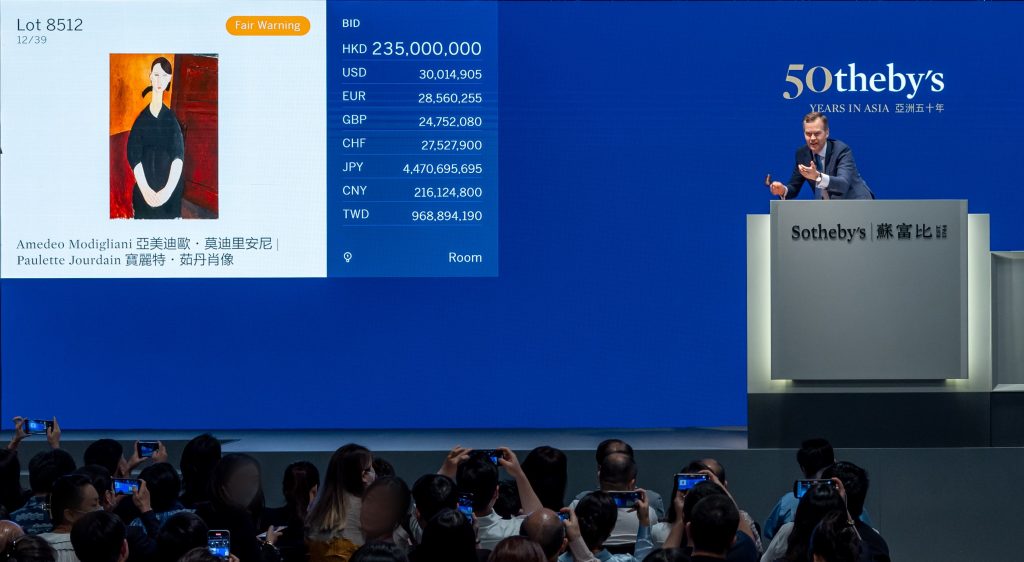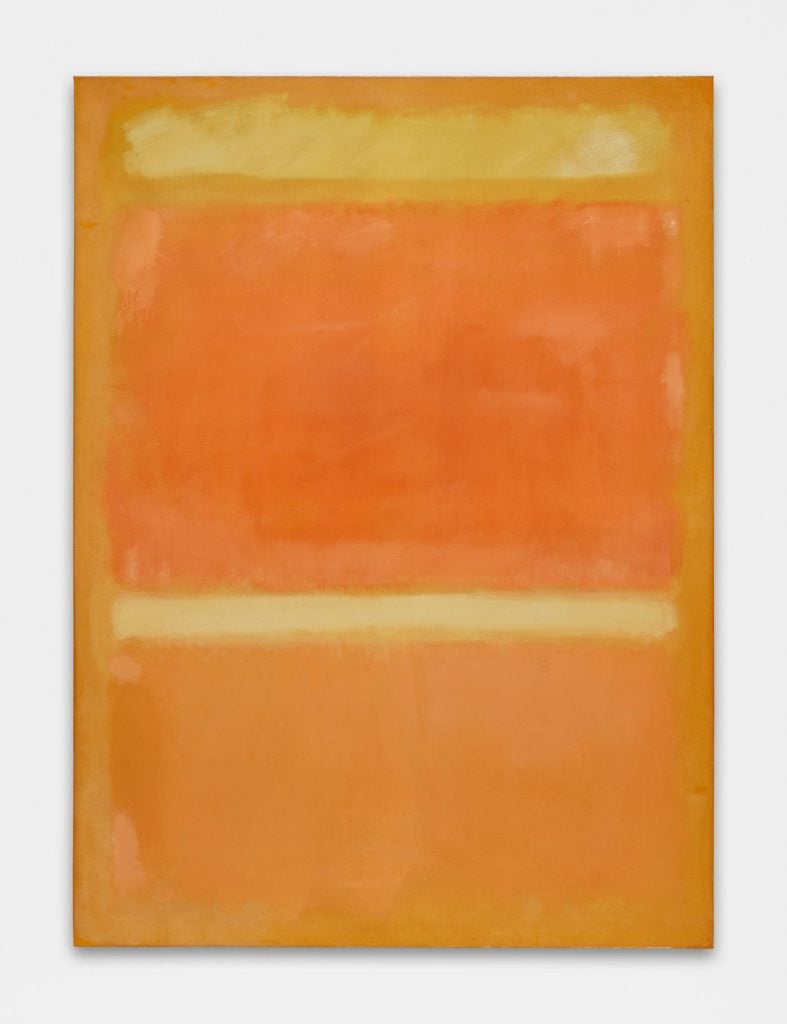The Back Room
The Back Room: Art-Market Correction Spreads
This week: The Long Museum sale’s long-term impact, Steve Wynn’s Rothko that never sells, and much, much more.

This week: The Long Museum sale’s long-term impact, Steve Wynn’s Rothko that never sells, and much, much more.

Artnet News

Every Friday, Artnet News Pro members get exclusive access to the Back Room, our lively recap funneling only the week’s must-know intel into a nimble read you’ll actually enjoy.
This week in the Back Room: The Long Museum sale’s long-term impact, Steve Wynn’s Rothko that never sells, and much more—all in a 7-minute read (2076 words).

The sale of Amedeo Modigliani’s Paulette Jourdain (1919), the star lot of the auction of Long Museum collection at Sotheby’s Hong Kong on October 5, 2023. Courtesy Sotheby’s.
The art market’s contraction is in full swing, and it’s hitting Asia particularly hard amid broader economic woes, as evinced by dire auction results in Hong Kong this week, including a highly anticipated sale that one insider afterwards deemed “a bloodbath.”
Sotheby’s is feeling the pain first. Its contemporary and modern evening sales this week, as well as the auction of the collection of Liu Yiqian and Wang Wei—the Chinese mega-collectors behind Shanghai’s Long Museum—registered subpar totals, even as several records for Asia were set. Our own Vivienne Chow drilled into the numbers and explored the contradictions that make this market moment at once alarming, confusing, and also sadly predictable.
In August, when Artnet News broke the story that the billionaire founders of the Long were planning to offload $150 million worth of art, there was shock and confusion given the timing, with the art market cratering. Global auctions at Christie’s, Sotheby’s, and Phillips fell 22.7 percent in the first six months of 2023 compared to the same period last year, according to Artnet’s Price Database.
But there were high hopes for the trove’s star lot, Amedeo Modigliani’s 1919 painting Paulette Jourdain. Alas, it hammered down at HK$235 million ($30 million), even following an intense bidding war, on Thursday (October 5). That was a surprising sum because…
The Modigliani wasn’t the only harbinger of art-market malaise in the single-collection sale, either.
The Long Museum collection sale is also illustrative of the contradictions in this market. Despite the discount price compared to its auction history, the Modigliani trade notched several records, including for the artist in an Asian auction. The painting also became the most valuable modern Western work ever sold in the region, as well as the third most-expensive Western artwork of any category to be sold in Asia.
So is Asia’s art market feeling then correction more acutely than other places? Or are these dismal outcomes outliers?
While the global economy is shaky, the Chinese economy is practically in freefall, as its besieged property market drags down the whole continent’s growth outlook. This week, the World Bank cut its projection for China’s 2024 GDP to 4.4 percent, well below pre-pandemic rises of between 6 and 7 percent. A Reuters poll estimates 70 percent of Chinese household wealth is tied up in real estate.
So, perplexed observers ponder, why is anyone selling now? Liu and Wang are purportedly exiting in order to free up funds to buy other art and “refresh” their collection. While an auction house source said the pair is actively buying at the moment, including for the museum. The source suggested that the auction’s proceeds might help the couple fund things like educational programs related to their museum as well.
Given the Chinese economic headwinds, the timing might still feel strange, but in fairness, some sectors are performing well, if grabbing fewer headlines. Consumer spending has recently picked up, for example, according to British Chamber of Commerce data cited by Bloomberg.
However, the choice to sell now may have impacts beyond the collectors’ pocketbooks.
Chinese dealers and collectors have fought for regard in the international art market in recent years. Some were concerned when Ding Yixiao, a contemporary art collector who founded the Xiao Museum of Contemporary Art in Rizhao, China, ran into reputational difficulties. Or when Chinese collector Michael Xufu Huang, founder of Beijing’s X Museum, found himself in hot water after a 2022 lawsuit exposed a messy flip of a Cecily Brown painting he had acquired. They were worried that the scandal would have ripple effects for the Chinese-speaking art world.
Now, with yet more prominent Chinese collectors who ostensibly own “private museums” engaging in swift resales, there are concerns the affair is a step backwards for the whole community. Will these worries stifle Chinese collectors’ access to Western galleries following the Long collection “bloodbath”? And where would that leave Chinese and Western dealers and collectors alike?
—Guelda Voien and Vivienne Chow
The latest Wet Paint was still being mixed at press time. Here’s what else made a mark around the industry since last Friday morning…
Art Fairs
Auction Houses
Galleries
Institutions & Biennials
Tech and Legal News
“I’m one of the bad guys who ends up good. Maybe I started out as a devil, but it’s better to do that and end up an angel than the other way around, right?”
—Stefan Simchowitz, once the enfant terrible of art dealing, who has pivoted to a less controversial art-rental business in recent years, to the Wall Street Journal.

Mark Rothko, Untitled (Yellow, Orange, Yellow, Light Orange) (1955). © 1998 Kate Rothko Prizel & Christopher Rothko / Artists Rights Society (ARS), New York.
Date: 1955
Seller: Steve Wynn
Estimate: Around $45 million
Selling at: Christie’s New York
Sale date: November 9, 2023
Of all the spectacular works on view at Art Basel in Switzerland this summer, this fiery, vital canvas in shades of orange by the modernist master grabbed eyes for both its beauty and its superlative as the most expensive piece of art for sale at the fair. Acquavella Galleries proudly hosted the painting in its booth with a handsome asking price of $60 million. However, the piece failed to sell, despite having been touted for sale for several years now, ping-ponging between auction houses and iterations of Art Basel.
A quick summary of those recent moves: The work was last up for auction in 2014 at Sotheby’s, when it sold to the Nahmad family for $36.6 million from the collection of Paul Mellon. Four years later, they sold it at Art Basel Miami Beach to Steve Wynn—who currently owns the piece, and is presumably putting it up for sale at what could be a loss, per Christie’s estimate—for $50 million.
The work comes back to auction at an incisive moment for the Rothko market. Next week, the Fondation Louis Vuitton is opening a massive retrospective comprising 115 paintings by the artist, his first dedicated retrospective in France.
At the same time, Pace is bringing a slate of works by contemporary artists inspired by Rothko to the Grand Palais for the second edition of Paris+ (Lee Ufan, Loie Hollowell, Adam Pendleton, and Robert Longo among them). Also getting in on the hype is the Phillips Collection, which just announced that they’ll be reopening their “Rothko Room” in Washington D.C. with three Rothko paintings new to the house, which come in on loan from the collections of the artist’s kids, Kate Rothko Prizel and Christopher Rothko.
Ahead of the November auctions and the European fairs, Untitled (Yellow, Orange, Yellow, Light Orange) could serve as an indicator for whether the momentary hype around Rothko is enough to propel an eight-figure sale during an economic downturn.
—Annie Armstrong